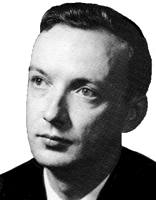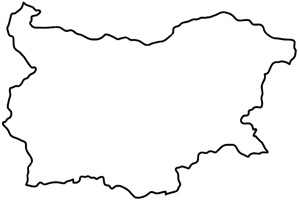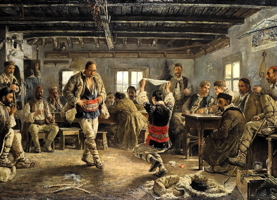
|
The Society of Folk Dance Historians (SFDH)
About Rŭčenica
[
Home |
About |
Encyclopedia | CLICK AN IMAGE TO ENLARGE |

|
 Rare is the Bulgarian who cannot dance the Rŭčenica or Râčenica (rutch-in_EE-tsa). Whether linked with other dancers in a pulsating chain weaving around a dusty village common, or alone, displaying his or her dancing skill for a gathering of friends, or competing with another dancer in a village tavern, the Bulgarian can become transformed moving to the insistent rhythm of this most beloved of all Bulgarian folk dances.
Rare is the Bulgarian who cannot dance the Rŭčenica or Râčenica (rutch-in_EE-tsa). Whether linked with other dancers in a pulsating chain weaving around a dusty village common, or alone, displaying his or her dancing skill for a gathering of friends, or competing with another dancer in a village tavern, the Bulgarian can become transformed moving to the insistent rhythm of this most beloved of all Bulgarian folk dances.
The rubric Rŭčenica covers several dance forms: there are solo, couple, tri, chain, line, and free-for-all versions, performed at all festive occasions, particularly weddings. The common denominator of all Rŭčenici forms is a quick-quick-slow (q-q-S) rhythm pattern conventionally notated in 7/16 meter (2-2-3).
The most common step for the dance, the so-called 'Rŭčenica step', is a simple pattern of three running steps per measure, RLR, LRL, etc. In chain or line forms, series of these steps are used in various patterns to make the whole configuration move gradually to the right (counterclockwise around the dance area).
The name Rŭčenica is derived from "rŭčenik" (rutch-in-EEK), a rectangular kerchief which is a common costume piece throughout Bulgaria, and is used as a prop in many versions of this dance. The rŭčenik also has certain ritual functions; for example, it is worn over one shoulder by important participants in weddings, funerals, and other folk ceremonies.
 By far the best known forms of the Rŭčenica are the solo and partner forms, which have achieved a place equivalent to that of a "national dance." Long before World War II, the Rŭčenica could be seen in balletic versions on concert stages (Anatol Joukowsky once showed me a cherished photo of him and his wife dancing it before the king), and was mentioned in literature (the writer Elin Pelin made it a pivotal episode in his well-known short story, "The Windmill". The artist Ivan Mrkvička portrayed the male Rŭčenica in two paintings (one of which was reproduced on the cover of Folk Dance Scene for the December 1983 issue), and numerous composers produced full concert works based on its rhythms and themes. Bulgarian children learned regimented group versions of it in schools and performed it at special patriotic programs.
By far the best known forms of the Rŭčenica are the solo and partner forms, which have achieved a place equivalent to that of a "national dance." Long before World War II, the Rŭčenica could be seen in balletic versions on concert stages (Anatol Joukowsky once showed me a cherished photo of him and his wife dancing it before the king), and was mentioned in literature (the writer Elin Pelin made it a pivotal episode in his well-known short story, "The Windmill". The artist Ivan Mrkvička portrayed the male Rŭčenica in two paintings (one of which was reproduced on the cover of Folk Dance Scene for the December 1983 issue), and numerous composers produced full concert works based on its rhythms and themes. Bulgarian children learned regimented group versions of it in schools and performed it at special patriotic programs.
Among the rural population, the solo and couple Rŭčenici are un-choreographed, spontaneous dances based on improvisation, display of skill, and competition. For the men, the dance serves not only to let off surplus energy, but to demonstrate the culturally valued traits of strength, endurance, and agility. The Rŭčenica is considered the supreme male dance. The Dobrudžan men's version, called Rŭčenik, is very rich; it is performed in strictly defined formations (columns, lines, circles) in slow tempo, and contains movements imitative of various work processes. When danced as a competition between two, three or more males, the Rŭčenica can last a very long time, the men gradually removing their coats, jakets, and vests. The men's variations entail athletic feats such as leaps, crouches, dancing in "push-up" position on the floor or atop items such as grain "sinici" (containers) or jugs.
The women's style is much more restrained, concentrating on graceful hand and arm movements, delicate flourishing of the kerchief, and, in some versions, mimetic gestures representing such traditionally feminine tasks as the kneading and stretching of dough.
The village versions differ enormously from the stylized forms adapted to the stage; for one thing, tradition forbade a young man and woman to dance the Rŭčenica unless they were close relatives. The "cute" flirtation elements (kissing behind the kerchief, snaring the girl with the young man's sash) seen in many staged versions are pure fantasy, and do not portray the true character of the original village dance. At most, a young village man and woman would engage in playful competition during a couple Rŭčenica. An important feature of the couple Rŭčenica is that there is never (well, hardly ever) any physical contact between the dancers. In any case, the couple form is pretty much restricted to relatively small family gatherings – rarely is it seen at a large public event (in a village square, for example).
Weddings were and still are the best opportunity to observe the Rŭčenica. Besides being done informally many times at the wedding celebration (which used to last several days), the Rŭčenica is also the form used in most of the ritual-dance moments of the wedding scenario. For example, as the groom's friends are giving him his ritual shave, his mother circles them with Rŭčenica steps, holding a bucket of water with geraniums in one hand, and carrying a young male child in her other arm, as a symbolic act meant to insure fertility and prosperity. The bride's girl friends dance the Rŭčenica around her at several moments during the celebration. Also, the wedding procession through the village streets, led by the "petelžija" (person carrying the ritual live rooster) is done in Rŭčenica steps. This ritual association of the Rŭčenica is one of the evidences of the dance's antiquity.
Viewed in a broader geographical context, the Rŭčenica is the Bulgarian representative of a large family of solo/non-contact couple dances still found today in the Balkans and Eastern Europe – the Russian Pljaska and Perepljas, the old Hungarian Ugrós, and the Albanian Shota are good examples, all pointing to the possible widespread existence of this kind of individual improvised dance in times past.
Today the Rŭčenica is holding its own in Bulgaria against the onslaught of other "imported" Western ballroom dances, even in urban settings. I once saw a group of four Bulgarian diplomats at a formal gathering doff their formal jackets to engage in a forty-five minute Rŭčenica competition! Also, what might be called the 'Rŭčenica Waltz', that is, the Rŭčenica step done in closed ballroom position, has been popular for many years in Bulgarian towns as well as villages.
Among United States folk dancers the solo and couple forms of the Rŭčenica have become marginal repertory items in the last five years or so; several line or chain Rŭčenici have become popular (Kjustendilska Rŭčenica, Gjuševska Rŭčenica, Starčeska Rŭčenica, Horo-Rŭčenica), and versions of the Thracian Rŭčenica for Three are done by some groups around the country. The notable increase in the number of "improvised" dances now entering the American folk dancers repertory (as opposed to the pre-packaged fixed routines of former times) may well mean that solo and couple versions of the Rŭčenica will gain popularity here.
DOCUMENTS
Printed as "The Rŭčenica" in Folk Dance Scene, May/June 1984.
This page © 2018 by Ron Houston.
Please do not copy any part of this page without including this copyright notice.
Please do not copy small portions out of context.
Please do not copy large portions without permission from Ron Houston.